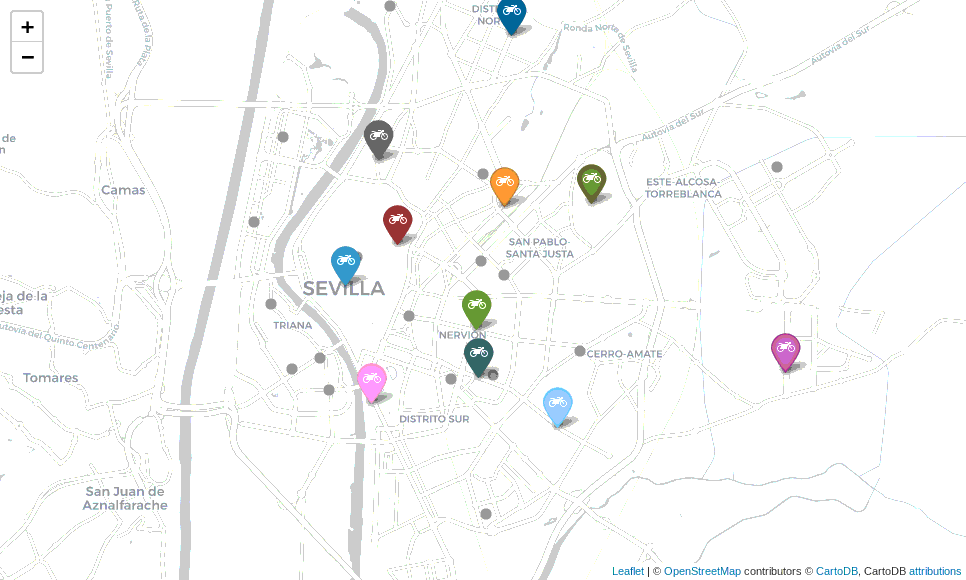Logistic productivity

La delivery management It is one of the most important and important parts of any logistics company and, therefore, it is essential to incorporate the proactive monitoring in our operations, in order to carry out the provision of services in a satisfactory manner.
El Rise of online commerce, especially after the pandemic, is further evidence of the paradigm shift in terms of the purchasing habits of the vast majority of consumers, since a new scenario is being proposed where the great advantages of ecommerce, such as the convenience of shopping anywhere or the possibility of buying products and prices.
Taking into account that this e-commerce model is here to stay and will most likely grow and innovate in the coming years, it is essential to ensure optimal management of logistics resources in order to offer efficient and satisfactory delivery management for customers.
In this regard, organization, efficiency and, especially, the ease of adaptation in deliveries are key factors in achieving fast and optimal deliveries. All of this will contribute greatly to the satisfaction of our customers and, therefore, to the good image of our company.
For all these reasons and given the importance of managing deliveries, today many companies have chosen to implement specialized software in the last mile to carry out the operation of deliveries in an efficient manner. The incorporation of specialized tools for last-mile management in logistics companies is the solution to many of the inconveniences that may arise, such as poor planning in deliveries or keeping an exhaustive monitoring of operations in order to carry out a more productive and satisfactory delivery.
Proactive monitoring
As stated before, delivery management is already a determining factor in the proper functioning of any logistics company and the implementation of tools to help us manage it is becoming increasingly important.
In this regard, it is important to take into account concepts such as proactive monitoring.
What is proactive monitoring?
La proactive monitoring It is the live monitoring of the daily planning of services and deliveries that warns of possible failures and errors while allowing us to react and adapt operations in a satisfactory manner.
What should good proactive monitoring look like?
Precisely, adequate proactive monitoring must have sufficient tools and functionalities that allow our operations to react favorably in time.
In this way, it is essential that Let's incorporate delivery management tools that have proactive monitoring and that it be comprehensive enough.
To keep in mind, good monitoring must have the possibility of carrying out the Real-time monitoring of operations: to be able to view at any time and live what the operation is going on.
In addition, and in relation to the real-time monitoring of operations, it is essential that it incorporates sufficient functions that allow a timely reaction to possible failures or errors. For example, it's important to consider the possibility of change in the order of stops or services. In the event of an unforeseen event and we must give priority to one stop over the rest, it will be essential that we have the right tool that allows us to make this change easily.
On the other hand, it is also important in terms of proactive monitoring, that our delivery management software also has the possibility of being able to carry out a change in the assignment of services between one driver and another. For example, thanks to the live view, we can see how one of our drivers must deviate from the route and there is one stop waiting to be made: in this case, we can easily change the assignment of that stop from one driver to another, so that said stop or service can be performed correctly.
Proactive monitoring is also very important when it comes to our customers. Thanks to being able to carry out an exhaustive and live monitoring of the operation, it will be possible to give our customers timely notice of, for example, a delay, which will have allowed them to react and then be able to perform the service efficiently.
All of these features and functions of proactive monitoring are essential, but it is also important to consider the magnitude of the operation and how stressful it can be. Therefore, it is also important to keep in mind that proactive monitoring can be done in a way comfortable and friendly: to be able to know what is happening on a single screen and without having to press the different Inputs on a consistent basis.
To do this, we must incorporate a tool that allows proactive monitoring to be possible and complete but, in addition, that it is independent and that we only have to have the screen open without having to be constantly aware, but simply to see sideways that everything is going as planned or that some of the routes are having unexpected behavior. That's when we'll need to pay attention and identify how to solve the problem.
Differences between proactive and reactive monitoring
Although it is true that more and more companies are betting on continuous improvement and are incorporating mechanisms such as monitoring given their great benefits, there are still laggards that are left behind doing reactive monitoring, a way of proceeding that is currently obsolete.
By proactively monitoring, we can move forward to potential problems. An informed customer at all times allows us to act quickly in the face of any incident, offering solutions proactively, such as arriving later than expected. Being proactive allows us to move forward to possible problems that may arise and not only to avoid them, but also to think about customer satisfaction by offering solutions and alternatives, which they will undoubtedly value very positively.
On the other hand, reactive monitoring does not contemplate possible problems that may arise. It only takes them into account once they have occurred, usually when the wait is longer than usual. At that point, it's too late to provide a satisfactory solution to the customer.
The usual case, when a customer makes the decision to call. This situation is usually due to the lack of information and visibility to the customer, which does not allow them to adapt their daily lives to the operational one. This situation creates stress and uncertainty for the client. The call is a sign that any changes we make to meet that customer's demand will generate extra delays for the rest and not only that, the added pressure for drivers.
With SmartMonkey Planner you can enjoy all the advantages of being able to carry out proactive monitoring, since it is a software specialized in last mile management that has a multitude of functions so that you can easily monitor and adapt your operations at any time.
If you want to position yourself ahead of your competitors, join Planner. In addition, you can sign up now without obligation, we have a free 10-day trial period.
Do you want to know if you make some of the most common mistakes in the last mile and how to fix them? Go to our article The 4 mistakes to avoid in the last mile and we explain it to you.

On November 26th, that is, in exactly 50 days, a new edition of Black Friday will be held. A commercial event of American origin that has managed to establish itself with great force around the world in recent years.
Even with the Covid-19 pandemic very present and its inevitable commercial consequences, especially the disproportionate rise in sea freight prices (with a notable impact on trade between China and Europe), the traditional Black Friday will go ahead, despite the “metamorphosis” of the situation.
In this article, we offer you the keys and key aspects of the last edition of the most commercial Black Friday so that you can learn first-hand about the expectations and forecasts of D-Day logistics.
Collapse and rise in prices in maritime freight: How does it affect Black Friday 2021?
Over the past year and a half, electronic commerce has been faced squarely with different problems affecting its good development. One of the first setbacks for the ecommerce it has undoubtedly been a consequence of Covid-19: during the lockdown, many online stores were unable to meet the huge demand, thus causing various logistical problems and even the collapse. In addition, the now popular stranding of the Evergreen vessel and the consequent blockage of the Suez Canal, whose consequences were serious delays for many companies worldwide.
In the same way, in recent weeks, the well-known container crisis has spread, whose impact has shaken the world economy in addition to causing the closure of some ports, such as China. For the Asian country, the closure of a terminal of what is currently the largest port in terms of container traffic on a global scale has caused delays, difficulties as well as an uncertain future for all ecommerce, especially for the next edition of Black Friday 2021 and the Christmas season, the two periods with the highest number of sales in the entire year.
It should be emphasized that all of these problems in the logistics network have consequences not only in terms of delivery times, but also in terms of the final price for users (with a longer transport time, the higher the cost of transport).
And what's the alternative? Companies such as Alibaba have found air transport as a temporary alternative to be able to maintain their logistics operations, an interim solution that has allowed them to maintain the delivery times of their customers in the European market.
Forecasts for Black Friday 2021
Thanks to the article Black Friday 2021 statistics: 10 numbers you should know with the help of the company Oberlo, we offer you below a summary of some of the most significant statistics for the logistics sector ahead of the next edition of Black Friday.

Sales forecasts
Many users choose Black Friday as a special date to advance Christmas shopping with great discounts given the proximity between the two dates.
In fact, in the 2020 edition of Black Friday, sales were so high that they even represented 30% of annual revenue.
Despite not yet having forecasts for the Black Friday 2021 edition, from companies such as In Markerter estimate that in the United States alone, the increase in online sales by that date will be approximately 11.3%.
A third of Spanish adults plan to shop on Black Friday 2021
For this next edition of Black Friday, approximately 13 million Spaniards are expected to shop on the famous “Black Friday”. Of all of them, it is estimated that 78.41% will make their purchases in person while 21.59% will make them through e-commerce. With regard to age groups, it is estimated that it is precisely the generation that expects to spend the most throughout the day.
Average spending on Black Friday 2021
According to the company Deloitte, the average expenditure among Spaniards will be 127 euros during the Black Friday weekend, also including the well-known Cyber Monday. Thus, this average expenditure per person would mean that Spaniards will already spend 23% of the budget reserved for Christmas on Black Friday.
It should be noted that in other countries, such as Mexico, the average expenditure per citizen is 279 American dollars, a significantly higher outlay.
The best-selling products
The products most acclaimed by users for Black Friday are, first of all, technological products, with a total of 39.2% of total sales. Secondly, another big star of this important date are fashion products and accessories, with a total of 33.74% of sales. And finally, leisure and entertainment plans, which win the bronze medal in terms of sales, since they account for around 7.55% of the total.
Do you want Black Friday to be a success for your company? We have the solution! Visit our article Ecommerce: 5 essential tools to survive in 2021 to learn about the most interesting applications for your company.
Logistics trends in ecommerce
It is well known that parcel delivery companies have a lot of difficulty offering a good service during these dates. Neither infrastructures nor personnel are adapted to such a sharp increase in operations. For this and other reasons, a trend is starting to appear in large e-commerce. The internalization of delivery processes in areas with the highest order density.
Currently, only companies with a large number of warehouses (stores) and requirements such as the cold are betting on this change, such as Mercadona, which already distribute their own fleet of gas-powered vehicles. We will see this trend in big brands that are increasingly considering e-commerce. The objectives are clear, better services, lower costs, but also to achieve visibility in the offline world by being able to conspicuously label your vehicles that are constantly moving around the cities.
In these cases, we are looking at route planning tools such as Planner, are very useful for simulating different scenarios and finding optimal logistics performance and determining the return on investment in this type of project. Stay tuned, in future articles we will go into the details of this type of analysis.

Find out how to improve logistics productivity in 4 simple steps
La productivity It is an essential indicator for analyzing the state and quality of logistics management of your company. Here are some of the recommendations that will help you increase logistic productivity of your company
Use of metrics and KPIs
To evaluate logistic productivity and process performance, the use of KPIs is essential (Key Performance Indicator). These indicators will help you measure and quantify your company's performance and compliance with established objectives. According to the article Logistics KPI: discover how to increase the productivity of your company from the technology consultancy Enzyme Advising Group, the incorporation of these parameters is an essential component in the success of any company.
It is recommended that when defining the logistics KPIs, they are developed based on the S.M.A.R.T. (Smart, Mmeasurable, Achivable, Realistic and Time-Bound) model:
- Specific: in line with your company's mission, vision and strategy.
- Measurable: Quantifying results will be key to strategy planning and subsequent decision-making.
- Achievable: define objectives as long as they are acceptable and real
- Realistic: objectives should be defined according to the capabilities and particularities of the strategy
- Time-limited: objectives with a limited period of time.
Within the KPIs, it must be taken into account which ones can be useful within each of the phases of the logistics process. This will make it easier for you to extract performance data from each department. Here are some of the most important in the different phases of the logistics process:
- Purchase and inventory: it is essential to measure the service offered by our suppliers and carry out an inventory in order to have a good organization (know the content, avoid possible errors and even reduce costs)
- Distribution: Quantifying the orders to be placed and evaluating the productivity of your employees will increase the efficiency of your warehouse
- Transportation: automating tasks related to transportation, thanks to the use of software specialized in route planning and optimization, will make the last mile an efficient and optimal process for your customers
- Order and delivery management: It is necessary to know times and quantities when carrying out a delivery service, since it will depend on increasing management and operational performance
Increase customer satisfaction
Prioritizing a stable relationship focused on customer satisfaction is the first step and an essential step to achieve success and thus increase logistics productivity.
To establish a good relationship with your customers, you must offer optimal communication throughout the process: it offers direct access, real-time monitoring of information, includes alerts, etc. It is also essential to guarantee adequate technical support: the resolution of incidents or questions that may arise quickly and effectively is essential for the satisfaction of your users. All of this will make them have all the information they may require and will help them build a much stronger relationship with your company, which will also have an impact on logistics productivity.
Optimizing resources: transport and logistics productivity
The optimization of resources when it comes to transportation is essential for the benefit and efficiency of your company, since it will help to control the traceability, trajectory and tracking of shipments. In addition, planning delivery routes efficiently and optimally will result in significant economic and time savings. Therefore, the use of specialized route planning software such as Planner, from SmartMonkey, will be a key element in increasing the logistics productivity of your company.
Design of planning systems, logistics scenarios and efficient warehouses
It is essential to have a good warehouse design, since it will have a direct impact on the supply chain and its effectiveness because this will help to manage one's own supplies properly and to greater logistic productivity.

The design or redesign of the warehouse should take into account key aspects, such as the prior analysis of the warehouse's space needs and associated areas, together with a previous study also of the expected inflow and outflow.
Do you want to know more aspects of the logistics market? We recommend that you read the article Digital transformation in the logistics sector: the 5 keys to achieving digital success to learn about the latest trends in the sector.
If you want to increase the logistics productivity of your business, join Planner and reinforce the scalability of your company.

Sant Jordi is always a special day, books, roses, queues and people, lots of people. Everyone is out on the street, enjoying a magical day for both children and adults. It is the day of the year when the most books are sold, 7.5% of annual sales In the city of Barcelona.

This year will be special. We'll have to spend it at home, enjoying a good read, our recommendation for these days The Black Swan by Nassim Taleb. This year we will save ourselves the hassle of Las Ramblas and we will have to buy the roses online. Without a doubt, a special year.
We want to take advantage of this important date to see the success of initiatives that, in a normal year, would hardly have achieved such overwhelming success.
One of our customers Santjordiacasa.com is using Highway as a tool to optimize the distribution of roses on such a special date as Sant Jordi.

Thanks to the power of the Highway route planner, they have been able to grow in deliveries and reach customers that would have been impossible for them before.
Like them, hundreds of other customers are entering a world such as home delivery. A channel that had often been completely forgotten. Thanks, or unfortunately, COVID-19 has forced the launch of new marketing channels such as Ecommerce and its own distribution and home delivery.
We are seeing this in our traditional customers, distribution companies to the HORECA channel that are converting to home distributors overnight.
Pastry shops such as Cropics they were able to deliver all the Easter monkeys in record time and have the detail of leaving a monkey at my wife's grandmother's house 😁. These types of details make being able to help small businesses make you proud of the work you do and of seeing how you can help more people around you.

We are in a very difficult time for many companies and families. There is little help to get through this crisis and reaching those people we can help is always a challenge. I encourage you to share our story, the story of our users and customers, companies that are embarking on a new adventure, delivery. Without experience, without processes, but with a desire to fight and face the corona, you are not alone.
We won this together.

The distribution on demand is an industry that is growing at a very high speed. New companies appear every day, especially in the market for food, beverages and deliveries of perishable products. And the competition is wild. Efficiency is a key metric in the “I want it all and I want it now” era and the most critical part is what happens from when a new order is placed until it is delivered.
Today I want to focus on the problem of sending new orders, that is, how to decide which courier service the order should be assigned to when an order enters the system. This is because the dispatch today is not addressed systematically. Optimizing the dispatch system can minimize delivery time and improve customer satisfaction.
The operating paradigm of companies that deliver on demand can be divided into two different types:
- Operations based on a single warehouse are those operations focused on a single tank. This warehouse has several dealers and the programming is done once to obtain an order list; usually grouping orders by area. Amazon Prime is a good example of this paradigm.
- Operations based on multiple warehouses are those operations that rely on choosing the order in one of the multiple warehouses and delivering it to a customer. In this case, the delivery people are scattered around the city, and once a new order arrives, it is assigned through a shipping process to one of the multiple delivery people. Companies such as Uber, Just Eat, Delivero, etc. operate this way.
The problem of dispatching is solved more or less satisfactorily in the first scenario thanks to the possibility of linking together a list of deliveries and considering it as a Traveling Seller Problem (Traveling Salesman Problem) with some pre-clustering restrictions (OK, I know that TSP is an expensive problem, but... come on, it's about Amazon).
On the contrary, in the second scenario, it is not so clear that the problem is being optimally addressed. How can a new incoming order be added to a running scenario? There are tons of variables to consider:
- Can the courier make multiple collections before starting to deliver?
- Can an already assigned order be reassigned to another courier service?
- Do all orders have the same priority? (for example, all orders must be delivered no later than 30 minutes after placing them)
Do orders need to be delivered by a particular vehicle? - ...

Modeling this scenario can be quite challenging, and that's why SmartMonkey has been working on this problem for a while. We call our solution Online Programming Optimization Model (OSOM) (Yes, branding isn't one of our strengths 😅, but phonetically it sounds like “incredible” and that's pretty fun). OSOM can model business restrictions and find a feasible solution to the dispatching problem.
In the simulation below, we have modeled a world where:
- A courier service can be assigned multiple pickups and deliveries at the same time
- and the first next service of each messaging service is fixed and cannot be reassigned in subsequent iterations.
The visualization contains twenty iterations of the world divided into two steps:
1. New incoming services are marked in gray.
2. Services are dynamically assigned to deliverers to optimize overall delivery time.






.png)


